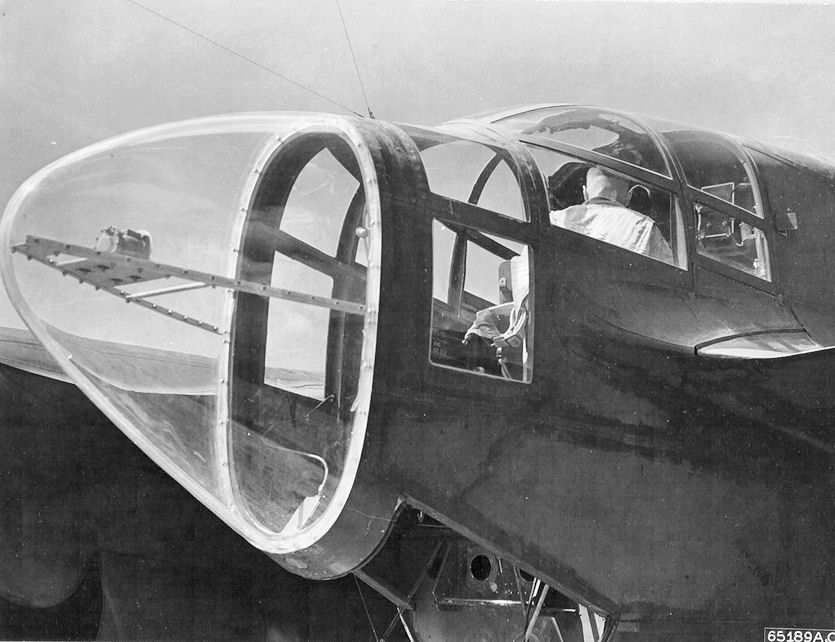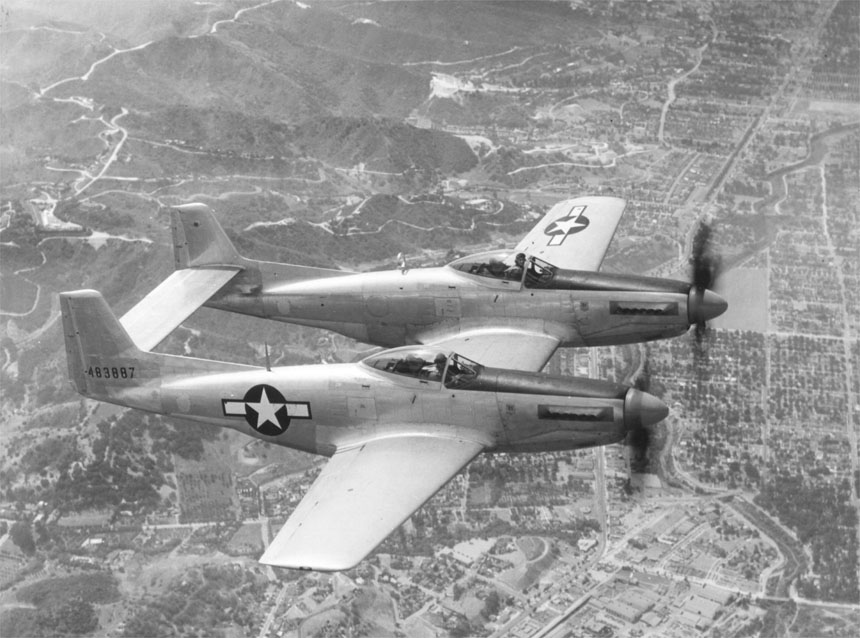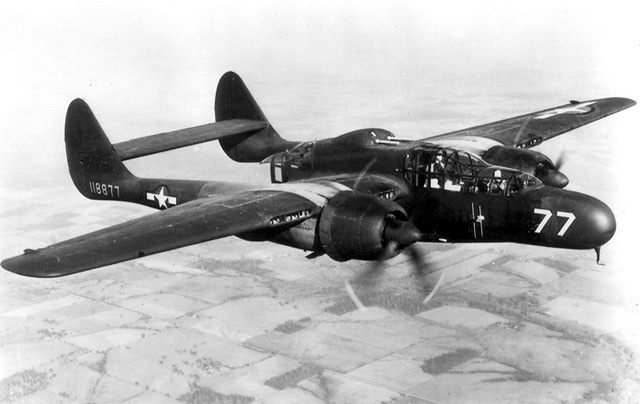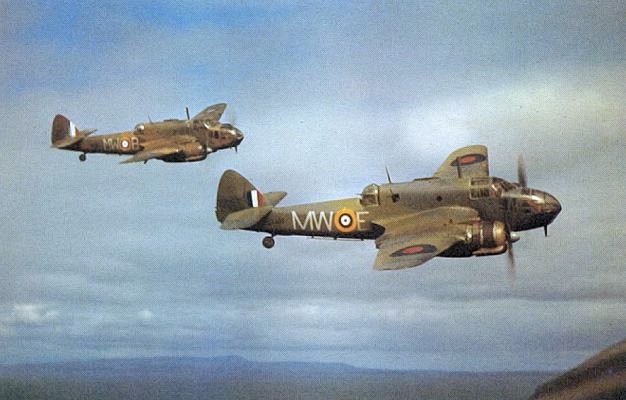|
XP-58
The Lockheed XP-58 Chain Lightning was an American long-range fighter developed during World War II. Although derived from the successful P-38 Lightning, the XP-58 was plagued by technical problems with its engines that eventually led to the project's cancellation. Design and development The XP-58 was a Lockheed Aircraft Company funded initiative to develop an improved Lightning as a long-range fighter following the release by the U.S. Army Air Corps of the Lightning for sale to Britain on 20 April 1940. Initially, two designs were formulated, both using the Continental IV-1430 engines. One would be a single-seat aircraft with one 20 mm (.79 in) cannon and four .50 caliber (12.7 mm) machine guns. The second would be a two-seat aircraft with the addition of a flexible .50 caliber (12.7 mm) gun at the end of each tail boom.Francillon 1982, p. 252. In July 1940, Lockheed decided to switch to Pratt & Whitney XH-2600 engines as the aircraft would be un ... [...More Info...] [...Related Items...] OR: [Wikipedia] [Google] [Baidu] |
Lockheed P-38 Lightning
The Lockheed P-38 Lightning is an American single-seat, twin piston-engined fighter aircraft that was used during World War II. Developed for the United States Army Air Corps (USAAC) by the Lockheed Corporation, the P-38 incorporated a distinctive twin boom, twin-boom design with a central nacelle containing the cockpit and armament. Along with its use as a general fighter aircraft, fighter, the P-38 was used in various aerial combat roles, including as a highly effective fighter-bomber, a night fighter, and a Range (aircraft), long-range escort fighter when equipped with drop tanks. The P-38 was also used as a bomber-pathfinder, guiding streams of medium bomber, medium and heavy bombers, or even other P-38s equipped with bombs, to their targets."P-38 Lightning" Na ... [...More Info...] [...Related Items...] OR: [Wikipedia] [Google] [Baidu] |
Hughes XF-11
The Hughes XF-11 (redesignated XR-11 in 1948) was a prototype military reconnaissance aircraft designed and flown by Howard Hughes and built by Hughes Aircraft Company for the United States Army Air Forces (USAAF). Although 100 F-11s were ordered in 1943, the program was delayed beyond the end of World War II, rendering the aircraft surplus to USAAF requirements; the production contract was canceled and only two prototypes were completed. During the first XF-11 flight in 1946, piloted by Hughes, the aircraft crashed in Beverly Hills, California, and was destroyed, critically injuring him. The second prototype first flew in 1947 but was used only briefly for testing before being scrapped in 1949. The program was controversial from the beginning, leading the United States Senate to investigate the XF-11 and the Hughes H-4 Hercules flying boat in 1946–1947. Development The F-11 was intended to meet the same USAAF operational objective as the Republic XF-12 Rainbow: a fast, ... [...More Info...] [...Related Items...] OR: [Wikipedia] [Google] [Baidu] |
Allison V-3420
The Allison V-3420 was a large experimental piston aircraft engine, designed in 1937 by the American Allison Engine Company. Design and development In 1937, at the behest of the United States Army Air Corps, the Allison Engine Company agreed to design and build a large-displacement high-power aircraft engine. The resulting V-3420 was essentially a pair of 12-cylinder Allison V-1710 engines mated to a common crankcase with a 30° angle between the inner cylinder banks. The crankshafts of the two V-1710 engines were geared together to drive a common propeller shaft. Most V-3420 parts were interchangeable with those for V-1710-E and -F engines. The V-3420 had a power-to-weight ratio of 1.6 kW/kg or 1 hp/lb, excellent for its time. It was envisioned as a powerful yet compact engine for several advanced USAAF projects of the day, including the Douglas XB-19, the Boeing XB-39 Superfortress, the Lockheed XP-58 Chain Lightning, and the Fisher P-75 Eagle. As none of these desi ... [...More Info...] [...Related Items...] OR: [Wikipedia] [Google] [Baidu] |
M4 Cannon
The 37 mm Automatic Gun, M4, known as the T9 during development, was a 37 mm (1.46 in) recoil-operated autocannon designed by John Browning, Browning Arms Company and entered service in 1942. The M4 and its variants would primarily be manufactured by Colt's Manufacturing Company and Oldsmobile (under-contract by Colt) and is therefore sometimes referred to as the "Colt M4" or "Oldsmobile M4." It was primarily mounted in the Bell P-39 Airacobra and Bell P-63 Kingcobra, P-63 Kingcobra, with the United States Navy, U.S. Navy also using it on many PT boats. Design Designed primarily as an anti-aircraft weapon, the gun had a muzzle velocity of and a cyclic rate of 150 rounds per minute. It was normally loaded with high-explosive shells, but could also be loaded with the M80 armor-piercing shell, which could penetrate 1 inch (25 mm) of Vehicle armour, armor plate at . It was magazine-fed and could be fired manually or by remote control through a solenoid mounted ... [...More Info...] [...Related Items...] OR: [Wikipedia] [Google] [Baidu] |
Pratt & Whitney XH-2600
The Pratt & Whitney X-1800 (later enlarged as the XH-2600) was an H-block aircraft engine project developed between 1938 and 1940, which was cancelled with only one example being built. Design and development The X-1800 was a watercooled 24-cylinder H-block of 2,240 in3 displacement;Gunston 2006, p. 163. this was later expanded to 2,600 in3 displacement.Connors, p. 147. It was intended to be used in the Vultee XP-54, Curtiss-Wright XP-55 Ascender, Northrop XP-56, Lockheed XP-49, and Lockheed XP-58 Chain Lightning. Projected performance was to be 1,800 to 2,200 hp (1350-1640 kW), with a turbocharger to secure high-altitude performance. The designation came from the intended power rating rather than the more usual cubic inch engine displacement figure.Gunston 2000 The target date for series production was 1942. In 1940, however, performance on the test bench did not continue to improve, demonstrating a need for considerable additional development effort. Pratt & Whitne ... [...More Info...] [...Related Items...] OR: [Wikipedia] [Google] [Baidu] |
Northrop P-61 Black Widow
The Northrop P-61 Black Widow is a twin-engine United States Army Air Forces fighter aircraft of World War II. It was the first operational U.S. warplane designed specifically as a night fighter. Named for the North American spider '' Latrodectus mactans'', it was an all-metal, twin-engine, twin-boom design armed with four forward-firing 20 mm (.79 in) Hispano M2 autocannon in the lower fuselage, and four M2 Browning machine guns in a dorsal gun turret. Developed during the war, the first test flight was made on 26 May 1942, with the first production aircraft rolling off the assembly line in October 1943. Although not produced in the large numbers of its contemporaries, the Black Widow was operated effectively as a night fighter by United States Army Air Forces squadrons in the European Theater, Pacific Theater, China Burma India Theater, and Mediterranean Theater during World War II. It replaced earlier British-designed night-fighter aircraft that had been up ... [...More Info...] [...Related Items...] OR: [Wikipedia] [Google] [Baidu] |
Wright R-2160 Tornado
The Wright R-2160 Tornado was an experimental 42-cylinder, 7-cylinder per row, 6-row liquid-cooled inline radial aircraft engine An aircraft engine, often referred to as an aero engine, is the power component of an aircraft propulsion system. Aircraft using power components are referred to as powered flight. Most aircraft engines are either piston engines or gas turbin .... It was proposed in 1940 with 2,350 hp (1,752 kW) for experimental aircraft such as the Lockheed XP-58 Chain Lightning, Vultee XP-68 Tornado, and the Republic XP-69. Specifications See also References * Kim McCutcheon, ''Tornado: Wright Aero's Last Liquid-cooled Piston Engine'' External links Republic XP-69 {{US military piston aeroengines 42-cylinder engines Wright aircraft engines 1940s aircraft piston engines Inline radial engines Abandoned military aircraft engine projects of the United States Water-cooled radial engines ... [...More Info...] [...Related Items...] OR: [Wikipedia] [Google] [Baidu] |
North American F-82 Twin Mustang
The North American F-82 Twin Mustang is an American long-range escort fighter aircraft, fighter. Based on the North American P-51 Mustang, the F-82 was designed as an escort for the Boeing B-29 Superfortress in World War II, but the war ended well before the first production units were operational. The F-82 was the last American piston-engined fighter ordered into production by the United States Air Force. In the postwar era, Strategic Air Command used the aircraft as a long-range escort fighter. Radar-equipped F-82s were used extensively by the Air Defense Command as replacements for the Northrop P-61 Black Widow as all-weather day/night interceptors. During the Korean War, Japan-based F-82s were among the first USAF aircraft to operate over Korea. The first three North Korean aircraft destroyed by U.S. forces were shot down by F-82s, the first being a North Korean Yakovlev Yak-11, Yak-11 downed over Gimpo International Airport, Gimpo Airfield by the USAF 68th Fighter Squadr ... [...More Info...] [...Related Items...] OR: [Wikipedia] [Google] [Baidu] |
List Of Aircraft Of World War II
The list of aircraft of World War II includes all of the aircraft used by countries which were at war during World War II from the period between when the country joined the war and the time the country withdrew from it, or when the war ended. Aircraft developed but not used operationally in the war are in the prototypes section at the bottom of the page. Prototypes for aircraft that entered service under a different design number are ignored in favor of the version that entered service. If the date of an aircraft's entry into service or first flight is not known, the aircraft will be listed by its name, the country of origin or major wartime users. Aircraft used for multiple roles are generally only listed under their primary role unless specialized versions were built for other roles in significant numbers. Aircraft used by neutral countries such as Spain, Switzerland and Sweden (or countries which did no significant fighting such as most of those in South America) are not include ... [...More Info...] [...Related Items...] OR: [Wikipedia] [Google] [Baidu] |
P-61 Black Widow
The Northrop P-61 Black Widow is a twin-engine United States Army Air Forces fighter aircraft of World War II. It was the first operational U.S. warplane designed specifically as a night fighter. Named for the North American spider ''Latrodectus mactans'', it was an all-metal, twin-engine, Twin boom, twin-boom design armed with four forward-firing 20 mm (.79 in) Hispano-Suiza HS.404, Hispano M2 autocannon in the lower fuselage, and four M2 Browning machine guns in a dorsal gun turret. Developed during the war, the first test flight was made on 26 May 1942, with the first production aircraft rolling off the assembly line in October 1943. Although not produced in the large numbers of its contemporaries, the Black Widow was operated effectively as a night fighter by United States Army Air Forces squadrons in the European Theater, Pacific War, Pacific Theater, China Burma India Theater, and Mediterranean Theater of Operations, Mediterranean Theater during World War II. I ... [...More Info...] [...Related Items...] OR: [Wikipedia] [Google] [Baidu] |
Bristol Beaufighter
The Bristol Type 156 Beaufighter (often called the Beau) is a British multi-role aircraft developed during the Second World War by the Bristol Aeroplane Company. It was originally conceived as a heavy fighter variant of the Bristol Beaufort torpedo bomber. The Beaufighter proved to be an effective night fighter, which came into service with the Royal Air Force (RAF) during the Battle of Britain, its large size allowing it to carry heavy armament and early aircraft interception radar without major performance penalties. The Beaufighter was used in many roles; receiving the nicknames ''Rockbeau'' for its use as a rocket-armed ground attack aircraft and ''Torbeau'' as a torpedo bomber against Axis shipping, in which it replaced the Beaufort. In later operations, it served mainly as a maritime strike/ground attack aircraft, RAF Coastal Command having operated the largest number of Beaufighters amongst all other commands at one point. The Royal Australian Air Force (RAAF) al ... [...More Info...] [...Related Items...] OR: [Wikipedia] [Google] [Baidu] |
M2 Browning
The M2 machine gun or Browning .50-caliber machine gun (informally, "Ma Deuce") is a heavy machine gun that was designed near the end of World War I by John Browning. While similar to Browning's M1919 Browning machine gun, which was chambered for the .30-06 Springfield, .30-06 cartridge, the M2 uses Browning's larger and more powerful .50 BMG (12.7 mm) cartridge. The design has had many designations; the official U.S. military designation for the infantry type is Browning Machine Gun, Cal. .50, M2, HB, Flexible. It has been used against infantry, light armored vehicles, watercraft, light fortifications, and low-flying aircraft. The gun has been used extensively as a vehicle weapon and for aircraft armament by the United States since the 1930s. It was heavily used during World War II, the Korean War, the Vietnam War, the Falklands War, the Soviet–Afghan War, the Gulf War, the Iraq War, and the War in Afghanistan (2001–present), War in Afghanistan. It is the primary heavy mac ... [...More Info...] [...Related Items...] OR: [Wikipedia] [Google] [Baidu] |







